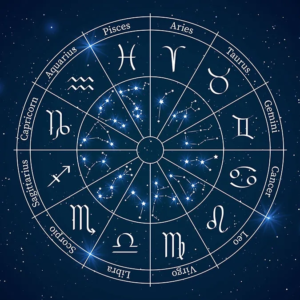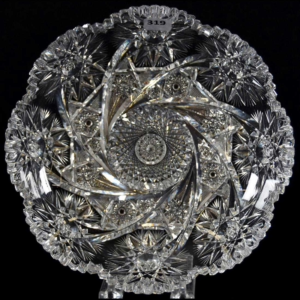cordierite – properties, virtues & benefits
Cordierite stone, also known as iolite, is a rare and fascinating gem that varies in color from blue to violet depending on the viewing angle. It is known for its hardness and heat resistance, making it a popular choice for jewelry and kitchen tools. Discover cordierite stone’s unique properties and fascinating history in our comprehensive guide.
CHARACTERISTICS OF CORDIERITY
- Chakra: Third eye, Crown.
- Properties: Psychic protection, intuition, creativity, emotional healing, meditation.
- Astrology: Saturn.
- Zodiac: Sagittarius.
- Elements: Water, Air.
- Colors: Blue, purple.
- Hardness: 7.5 – 8 on the Mohs scale.
- Chemical Formula: (Mg,Fe)2Al3(AlSi5O18).
- Associated god: Athena.
CORDIÉRITE – HIS HISTORY
The rock known as the “Viking stone” or “compass stone” is said to have been used by Athena’s followers in ancient times to worship the goddess, then later by the Vikings to orient themselves when the sky was overcast. It is also called cordierite stone in honor of engineer and geologist Louis Cordier, who first described it in 1813. The samples at the time came from Spain, but the topotype deposit is located in Germany. The stone was called “water sapphire” for a time, but this appellation was banned by the CIBJO because the stone is pleochroic, i.e. it changes color according to the light. Its high aluminum content gives it its uniqueness, and it is enhanced by a faceted or cabochon cut. Cordierite can be found in weights ranging from 1 to 10 carats, but the most remarkable stones rarely exceed 5 carats. In 1967, gemologists discovered tanzanite, which resembles cordierite in terms of hue.
CORDIERITE STONE – ITS ORIGIN AND COMPOSITION
Iolite stone, or violite, is a silicate mineral classified as a tectosilicate, with the chemical formula Al3Mg2AlSi5O18, with traces of Mn, Fe, Ti, Ca, Na and K. It is insoluble in water and fire-resistant, and is found in cordierite and andalusite schists. Its bluish color is due to its aluminum, iron and magnesium composition, but it can also show yellow and violet variations due to its pleochroism. Crystals can reach up to 18 cm in size and display a high degree of polychroism. The largest cut specimen weighs 855 carats and is in the British Museum. It is also known as New Zealand blue quartz or steinheilite. Iolite stone is prized for its transparent blue color and is often confused with other stones such as amethyst, quartz, tanzanite or serpentine.

CORDIERITE STONE – VERTIES AND PROPERTIES
PSYCHOLOGICAL CORDIERITY
Tanzanite stone is known to have numerous benefits on the psychological level, notably by promoting sleep and sPirituality. It helps with falling asleep and deeper sleep, also reducing nightmares. It can be placed close to the bed to benefit from its energies. It contributes to sPiritual upliftment and facilitates access to the higher planes during astral travel. It is particularly recommended for beginners in meditation and sPirituality, and helps develop clairvoyance and balance between life in communion with the earth and astral travel. It also helps relieve anxiety and negative emotions by releasing tension and fears, increasing feelings of security and self-confidence.
Tanzanite stone is also useful for resolving relational conflicts, transforming stress and fear into positive feelings. It is an excellent choice for twenty-first wedding anniversaries and can be offered as a ring or bracelet. Cordierite, on the other hand, enhances intuition and decision-making, and helps to communicate effectively by combining heart and mind. It is recommended for those who need to regain a healthy emotional base and achieve their goals, by attracting abundance and offering emotional comfort. It can be combined with other stones, such as hematite or sunstone, to reinforce its beneficial energies on the psyche. Cordierite stone is often used in lithotherapy to increase empathy and better understand patients’ needs.
PHYSICAL CORDIERITY
In addition to its many psychological benefits, iolite stone also has beneficial virtues for the human body. It is recommended for treating liver disorders, helPing to eliminate toxins and regenerate the liver, and for detoxifying in general, particularly in people suffering from addictions. In Brazil, it is used to treat troPical disorders that cause high fever, as it boosts the immune system and regulates body temperature. It also has beneficial effects on the kidneys, heart, resPiratory and cardiovascular systems, and helps regulate blood pressure. It acts on digestive disorders, circulatory discomforts and skin rashes.

CORDIERITE STONE – CLEAN AND RECHARGE
Cordierite stone can be cleaned and recharged in a variety of ways, here are some methods:
Cleaning:
- Water and mild soap: you can clean your cordierite stone with water and mild soap, using a soft brush to remove embedded dirt.
- Fumigation: you can also purify your stone by smoking it with incense or sage.
- Salt: you can place your stone in a bowl of salt for a few hours to deep-clean it, but avoid this method if the stone contains iron or magnesium, as this could damage it.
Loading:
- Sunlight or moonlight: you can expose your cordierite stone to sunlight or moonlight for several hours to recharge it.
- Earth: bury your stone in the ground for a few days to recharge it with earth energy.
- Quartz or amethyst: place your cordierite stone on a cluster of quartz or amethyst to recharge it with positive energy.
It is recommended to clean and recharge your cordierite stone regularly to maintain its energetic properties.
WHERE DOES THE NAME CORDIERITE COME FROM?
The name cordierite was given in honor of French mineralogist Louis Cordier, who discovered it in 1813 in the Esterel region of France. The stone was originally called “iolite” in reference to its property of changing color depending on the angle of vision, but the name “cordierite” was later adopted in recognition of Cordier’s contribution to mineralogy.
WHICH CHAKRA DOES CORDIERITY ACT ON?
Cordierite is known to act primarily on the third eye and crown chakras. The third eye is located between the eyebrows and is associated with intuition, clairvoyance and extrasensory perception, while the crown chakra is located at the top of the head and is associated with sPirituality, connection with the divine and opening of consciousness. Working with cordierite can strengthen and balance these two chakras, promoting greater self-understanding, mental clarity and sPiritual awareness.
WHICH ASTROLOGICAL SIGN IS ASSOCIATED WITH CORDIERITY?
Cordierite is associated with the zodiac sign Sagittarius. Sagittarius is a fire sign ruled by the planet JuPiter, which is known for bringing luck, expansion and personal growth. People born under the sign of Sagittarius are often described as adventurous, optimistic and curious, and can benefit from the energy of cordierite to strengthen their intuition, creativity and self-confidence.
CORDIERITE STONE SUMMARY
Cordierite is a mineral belonging to the silicate group. It is also known as “iolite stone” or “Himalayan moonstone”. Cordierite is characterized by its blue or violet color, although yellow and brown varieties also exist. It is often used as an ornamental stone or in jewelry. Cordierite is also used in industry as a refractory material due to its heat resistance and low thermal expansion. It is also used as a filtration material for molten metals and as a material for catalysts. Cordierite was first discovered in 1813 by French mineralogist Louis Cordier.

